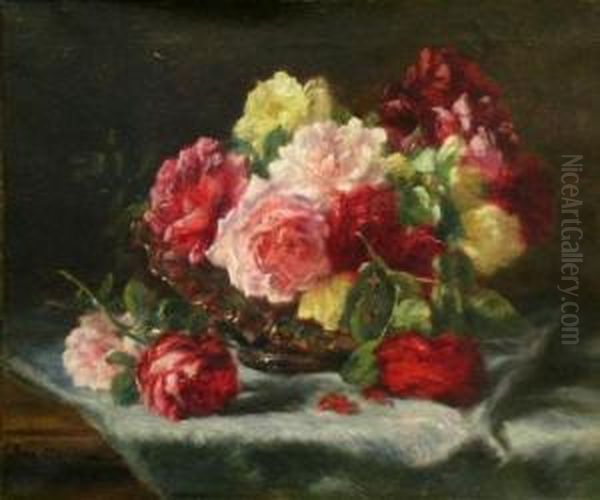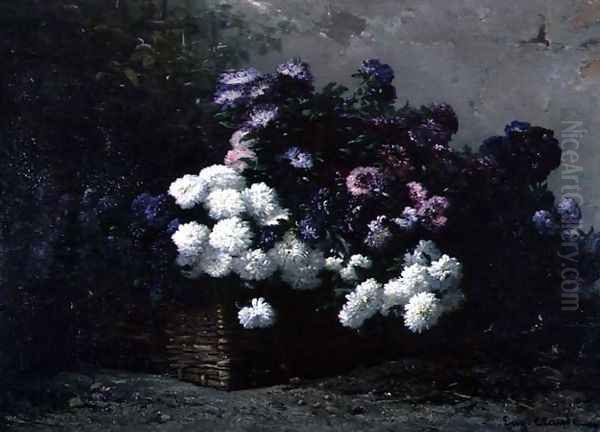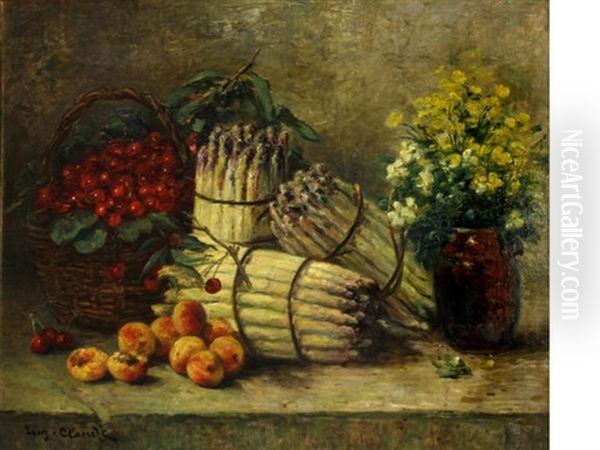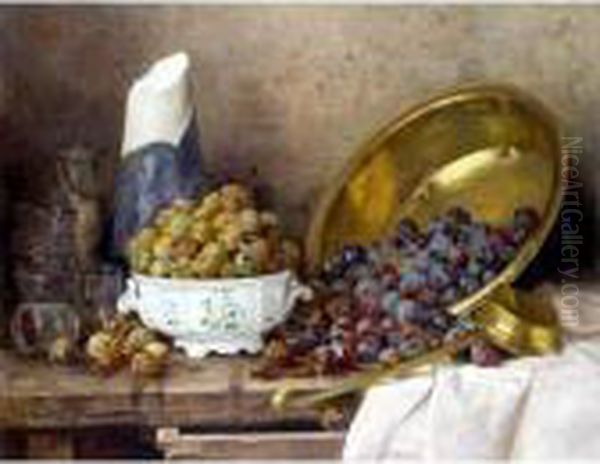Eugène Claude (1841-1922) stands as a significant figure in French painting during the latter half of the 19th and early 20th centuries. While perhaps not possessing the revolutionary renown of some of his contemporaries who spearheaded movements like Impressionism or Post-Impressionism, Claude carved a distinct and respected niche for himself. He excelled in the genres of still life, particularly floral and fruit compositions, and intimate interior scenes, often imbued with a sense of quiet domesticity and comfort. His work, characterized by meticulous detail and a refined technique, found favour with the public and critics alike, earning him recognition within the established art world of his time, most notably through regular participation and awards at the prestigious Paris Salon.
Early Life and Artistic Formation
Born in France in 1841, Eugène Claude entered the art world during a period of immense change and dynamism. The mid-19th century saw the established academic traditions challenged by emerging realist and, later, impressionist aesthetics. Information regarding Claude's earliest years and specific familial background remains somewhat scarce compared to more documented figures. However, it is known that his formal artistic training took place under the tutelage of Jean-Ernest Aubert (1824-1906).
Aubert himself was a pupil of the celebrated history painter Paul Delaroche (1797-1856), known for his dramatic historical scenes executed with precise detail. Aubert, however, gained more recognition for his genre paintings, lithographs, and portraits, often depicting elegant figures and scenes from contemporary life. This grounding, likely emphasizing strong drawing skills, careful composition, and a polished finish, would profoundly influence Claude's own artistic development. He absorbed the lessons of academic precision but applied them primarily to the less grandiose subjects of still life and everyday interiors.
Development of a Signature Style

Eugène Claude's artistic style is firmly rooted in Realism, yet it possesses a distinct charm and warmth that sets it apart. He was not a painter concerned with gritty social commentary like Gustave Courbet, nor was he capturing the fleeting effects of light outdoors in the manner of Claude Monet or Camille Pissarro. Instead, Claude focused on the tangible beauty of objects and the quiet atmosphere of domestic spaces. His approach involved meticulous observation and a high degree of technical skill in rendering textures.
Whether depicting the velvety softness of a rose petal, the cool sheen of porcelain, the reflective gleam of polished silver, or the rich nap of velvet drapery, Claude demonstrated exceptional ability. His brushwork is typically smooth and controlled, leaving little trace of the artist's hand, which aligns with academic finishing techniques favoured by the Salon juries. He paid close attention to the play of light, often using a warm, gentle illumination that enhances the richness of colours and creates a welcoming, intimate mood within his interior scenes.
The Allure of Still Life: Flowers and Fruit
Still life painting formed a cornerstone of Eugène Claude's oeuvre. He displayed a particular affinity for floral compositions, arranging bouquets with an eye for balance, colour harmony, and naturalistic detail. Roses, peonies, chrysanthemums, lilacs, and other garden flowers frequently feature in his canvases, often presented in elegant vases made of porcelain, glass, or faience. These were not mere botanical studies; Claude imbued his floral paintings with a sense of abundance and transient beauty.
His fruit still lifes are equally accomplished. He would arrange compositions featuring grapes, peaches, plums, melons, and other fruits, often alongside tableware, glassware, or decorative objects. The textures – the bloom on a grape, the fuzz on a peach, the smooth skin of an apple – are rendered with convincing realism. These works follow a long tradition of still life painting, harking back to masters like Jean-Baptiste-Siméon Chardin (1699-1779) in their appreciation for the humble beauty of everyday objects, yet updated with a 19th-century sensibility for richness and detail, perhaps also echoing the opulence seen in Dutch Golden Age painters like Willem Kalf (1619-1693), albeit in a French context.
Intimate Interiors and Genre Scenes
Beyond still life, Eugène Claude excelled in painting interior scenes that offer glimpses into the comfortable lives of the French bourgeoisie. These are not grand historical narratives or scenes of overt drama, but rather quiet moments observed within well-appointed rooms. Common settings include drawing rooms, studies, or dining areas, furnished with period furniture, decorative objects, carpets, and draperies, all rendered with the same meticulous attention to detail seen in his still lifes.

A particularly charming and recurrent feature in Claude's interiors is the presence of domestic animals, especially cats and dogs. These pets are often depicted lounging comfortably on chairs, playing near a fireplace, or interacting subtly with the scene, adding a touch of warmth, life, and anecdotal interest. Works often titled "Le Goûter" (The Snack or Afternoon Tea), "A Pampered Pet," or "Interior with Cat" exemplify this aspect of his work. These scenes capture a sense of peaceful domesticity and material comfort that resonated strongly with the tastes of his clientele. Unlike the more psychologically charged interiors of Edgar Degas or the socially observant scenes of Édouard Manet, Claude's interiors prioritize harmony, detail, and gentle sentiment.
Career at the Paris Salon and Recognition
The Paris Salon, the official art exhibition of the Académie des Beaux-Arts, was the primary venue for artists seeking recognition and patronage in 19th-century France. Eugène Claude became a regular exhibitor at the Salon, consistently submitting his works for consideration from the 1860s onwards. Success at the Salon was crucial for an artist's career, leading to sales, commissions, and critical notice.
Claude achieved notable success within this highly competitive system. His carefully finished paintings, demonstrating technical mastery and appealing subject matter, aligned well with the prevailing tastes of the Salon juries and the public. He received official recognition for his talents, including medals awarded at the Salons of 1881 and 1900. This consistent presence and acknowledgment cemented his reputation as a reliable and accomplished painter within the mainstream art world, distinct from the avant-garde circles challenging the Salon's authority. His contemporaries within the more academic or realist Salon milieu included artists like Jean-Léon Gérôme or William-Adolphe Bouguereau, though Claude focused on more intimate genres.
Representative Works
Identifying specific, universally acknowledged "masterpieces" for Eugène Claude can be challenging, as much of his work resides in private collections or regional museums rather than major international institutions. However, numerous examples typify his style and subjects:
Floral Still Lifes: Paintings titled simply "Still Life with Roses," "Bouquet of Flowers in a Vase," or similar titles abound. These typically showcase his skill in rendering delicate petals, varied foliage, and the reflective surfaces of their containers. The compositions are often abundant and colourful, celebrating the beauty of nature brought indoors.
Fruit Still Lifes: Works depicting arrangements of fruit, sometimes combined with flowers, game, or tableware, highlight his ability to capture diverse textures and the play of light on different surfaces. Titles might include "Still Life with Fruit and Wine" or "Peaches and Grapes on a Table."

Interior Scenes: "Le Goûter" (The Snack/Afternoon Tea) appears as a theme, often showing a table set with tea service, pastries, and perhaps a waiting cat or dog nearby, evoking a moment of quiet indulgence. "Chat et Souris" (Cat and Mouse) introduces a playful narrative element common in genre painting. Other interiors might focus on a reading corner, a fireplace setting, or a pet enjoying domestic comforts, emphasizing coziness and bourgeois well-being.
These works, while perhaps lacking the groundbreaking innovation of a Paul Cézanne still life, possess enduring appeal through their technical polish, charming subject matter, and faithful representation of textures and light.
Context within Late 19th Century French Art
Eugène Claude worked during a period of profound artistic upheaval. While he pursued his career largely within the established framework of the Salon, the art world around him was being transformed by Impressionism and its successors. Artists like Claude Monet, Pierre-Auguste Renoir, and Edgar Degas were revolutionizing painting with their focus on light, colour, modern life, and capturing fleeting moments, often employing looser brushwork and brighter palettes.
Claude, however, remained largely committed to the principles of Realism and academic finish learned under Aubert. His work shows an awareness of light but not the analytical, broken colour of the Impressionists. His subjects were contemporary but focused on the private, comfortable sphere rather than the bustling public life of Paris often depicted by the avant-garde. He can be situated alongside other successful Salon painters who specialized in still life and genre scenes, such as Antoine Vollon (1833-1900), known for his robust still lifes, or Henri Fantin-Latour (1836-1904), who, while famous for portraits and group portraits of artists, also produced exquisite, sensitive floral still lifes. Claude's work shares with these artists a dedication to representational accuracy and technical skill, appealing to patrons who appreciated traditional craftsmanship.
The rise of Post-Impressionism, with figures like Vincent van Gogh, Paul Gauguin, and Georges Seurat pushing artistic boundaries even further in terms of colour, form, and emotional expression, further highlights the relatively conservative nature of Claude's aesthetic. Yet, his adherence to realism and detail provided a different kind of satisfaction, one rooted in skillful mimesis and the appreciation of material beauty and domestic tranquility.
Market Reception and Legacy

During his lifetime, Eugène Claude enjoyed considerable success. His regular participation in the Salon and the awards he received indicate official approval, and his works found a ready market among the middle and upper classes who appreciated his skillful execution and pleasing subject matter. His paintings, suitable for decorating the interiors they often depicted, were popular choices for private collectors.
In the contemporary art market, works by Eugène Claude continue to appear at auction. While they do not command the astronomical prices of leading Impressionist or Modern masters, his paintings consistently achieve respectable sums, reflecting a continued appreciation for their decorative quality, technical accomplishment, and period charm. Auction results for his floral still lifes and interior scenes with pets demonstrate an enduring appeal for collectors specializing in 19th-century European academic and realist art.
Eugène Claude's legacy is that of a highly skilled and successful painter who mastered the genres of still life and intimate interiors within the realist tradition. He was not an innovator who changed the course of art history like his Impressionist contemporaries, but rather a dedicated artist who excelled within his chosen field, creating works of enduring beauty and charm. His paintings offer valuable insight into the tastes and domestic aesthetics of the French bourgeoisie during the late 19th and early 20th centuries. He represents the significant stream of artists who maintained high standards of craftsmanship and found success within the established Salon system, providing a counterpoint to the more radical artistic developments of the era. His meticulous attention to detail, skillful rendering of textures, and ability to capture quiet, intimate atmospheres ensure his place as a respected figure in French genre and still life painting. His work continues to be admired for its technical finesse and its gentle, appealing vision of domestic life and natural beauty.